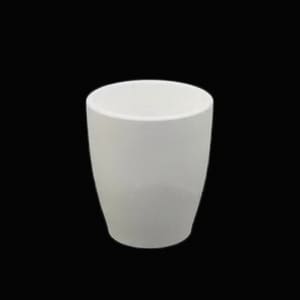Crucible is a vessel for melting and refining liquid metals and heating solid-liquid reactions, and it is the basis for smooth chemical reactions. To meet different needs, there are many different crucibles to choose from, among which the most widely used is ceramic crucible.
Ceramic crucible can be divided into quartz ceramic crucible, the physicochemical ceramic crucible, alumina crucible, and zirconia crucible according to the different raw materials, the most commonly used ceramic crucible is quartz ceramic crucible and physicochemical ceramic crucible.
First of all, let’s see what is quartz ceramic crucible and ceramic crucible.
Quartz ceramic crucible is called high purity fused silica ceramic crucible (silica content ≥99.9%). It is a ceramic crucible made of high purity fused silica as raw material. The crucible shape is generally square and cylindrical, where the square high purity quartz ceramic crucible is used in the polysilicon ingot casting process as a container for polycrystalline silicon and long crystals, and the round high purity quartz ceramic crucible is used in the single-crystal silicon pulling process.
Physico-chemical ceramic crucibles (hereafter referred to as ceramic crucibles) are generally used in chemistry laboratories and are composed primarily of alumina (45-55%) and silica, and are usually used with a matching lid.
Both quartz ceramic crucibles and ceramic crucibles have certain similarities, but they have differences.
1.Differences in Materials Used for Production
Quartz-ceramic crucibles use a quartz matrix with crystalline and glassy phases.
Ceramic crucibles use silicon dioxide and alumina as the base material.
2. Different acid and alkali resistance
Ceramic crucible is not resistant to strong alkali, and generally cannot be used for melting with alkaline substances such as NaOH, Na2O2, Na2CO3, etc. to avoid corrosion of porcelain crucible.
Quartz ceramic crucible acid and alkali resistance, but can not and hydrofluoric acid contact, high temperature, very easy and caustic alkali, and alkali metal carbonate reaction, in addition to fused quartz ceramic crucible also has a melt (silicon, aluminum, copper, etc.) erosion resistance.

3. Different temperature resistance
Ceramic crucible and quartz ceramic crucible have different degrees of high-temperature resistance, quartz ceramic crucible can be used below 1450 degrees, ceramic crucible is generally used below 1000 degrees, and the maximum heat resistance is about 1200 degrees Celsius.
4. Stability of heat is different
Quartz ceramic crucible has good thermal shock stability and can be heated directly on the flame, while ceramic crucible is generally not heated directly on the flame, but will be put on the crucible stand for experiment or test with the help of crucible stand.
5. Price difference
The price of ceramic crucible is low, relatively speaking, the price of a quartz ceramic crucible is higher.
6. Application range is different
High purity fused quartz is widely used in glass deep processing industry, polysilicon production, non-ferrous metal metallurgy industry, electronic industry, chemical industry, aerospace, and other fields because of its fine structure, low thermal conductivity, small coefficient of thermal expansion, high dimensional accuracy of manufactured products, no deformation at high temperature, good thermal shock stability, good electrical properties, good chemical erosion resistance, etc.
Ceramic Parts India Inc.CO., Ltd, we are a global ceramics manufacturer and supplier, crucibles are shipped worldwide, please visit our website for more details. www.ceramicpartsindia.com